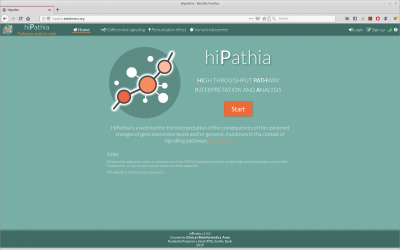A tutorial of hipathia, a mechanistic model of pathway activity
Kinza Rian 1, Macarena López-Sánchez 1, Joaquin Dopazo 1
Fundación Progreso y Salud, Sevilla, Spain 1
Abstract
Conventional gene-based approaches ignore the modular nature of most human traits, while pathway enrichment methods produce only illustrative results of limited practical utility. Recently, new methods have emerged that change the focus from the whole pathways to the definition of elementary circuits within them that have any mechanistic significance. In some cases, this involves the recodification of Process Description pathways into Influence Maps that describe how proteins interact among them to trigger or carry out cell functionalities. The activity of such circuits defined within Influence Map pathways is expected to be a better descriptor of cell functional activity than measurements for whole pathway or single gene activities. Here we present a tutorial on the HiPathia MPA method (1), implemented in a R/Bioconductor package (http://bioconductor.org/packages/devel/bioc/html/hipathia.html) as well as in an interactive web application (http://hipathia.babelomics.org/). This tutorial demonstrates how to transform decontextualized gene expression measurements into highly-informative cell activity quantitative values and how to relate them to phenotypes. Different analyses can be carried out using circuit activities that include differential activity analysis, when two conditions are compared, or relation of circuit activities to a continuous variable. Since circuits modeled have an associated functional meaning (any of them trigger one or more cell functions, defined by Gene Ontology terms), the results provide direct clues to understand disease mechanisms or drug modes of action. It is also possible to build predictors directly based on circuit activities, which adds an interesting mechanistic dimension to the prediction process. In addition to be used to uncover the molecular basis of phenotypes, mechanistic models can also be used to predict what would be the potential effect of one or several interventions (KOs, inhibitions, over-expressions, drugs, etc.) over the system studied. Thus, the PathAct (2) wen application (http://pathact.babelomics.org/) allows predicting from a holistic perspective what would be the effects of interventions over a specific system. The HiPathia suite provides a friendly environment to use Influence Map pathways as templates of cell functionality to provide a mechanistic interpretation of transcriptomics data.
M. R. Hidalgo et al., High throughput estimation of functional cell activities reveals disease mechanisms and predicts relevant clinical outcomes. Oncotarget 8,5160 (Dec 22, 2017). F. Salavert et al., Actionable pathways: interactive discovery of therapeutic targets using signaling pathway models. Nucleic Acids Res 44, W212 (Jul 08, 2016)
Workshop program: Hipathia Web-tool
- 10:00h - 10:40h.
General introduction about High Throughput pathway interpretation and analysis: Analysis of signaling pathways activation from genomic expression.
- Introduction to differential gene expression analysis
- Introduction to the use of biological systems for the analysis and functional interpretation of genomic expression: Hipathia
- 10:40h - 11:30h.
Worked example differential signaling: Provides an estimation of significant cell signaling activity changes across different conditions.
- 11:30h - 11:40h.
Break and open discussion
- 11:40h - 12:00h.
Worked example prediction: Allows you to train a prediction-test and test it with different data.
- 12:00h - 12:40h.
Worked example perturbation effect : an interactive working environment to simulate the effect of different interventions (e.g. knock-out, over-expression, etc.).
- 12:40h - 13:20h.
Worked example variant functional interpretation : Provides an estimation on the potential impact of genomic variation on cell signaling and ultimately on cell functionality.
- 13:20h - 13:30h.
Conclusion and questions. (other recommended tools: babelomics, metabolizer…)
Venue
- On-line
Organizers
- Clinical Bioinformatics Area, Fundación Progreso y Salud, Seville, Spain
Instructors: Clinical Bioinformatics Area team (Hipathia tutorial)
- Joaquín Dopazo
- Kinza Rian
- Macarena López-Sánchez




